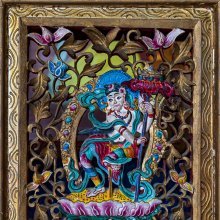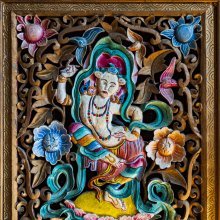Khadi, Khāḍi, Khādi, Khada: 15 definitions
Introduction:
Khadi means something in Buddhism, Pali, Hinduism, Sanskrit, the history of ancient India, Marathi, Jainism, Prakrit, Hindi. If you want to know the exact meaning, history, etymology or English translation of this term then check out the descriptions on this page. Add your comment or reference to a book if you want to contribute to this summary article.
Images (photo gallery)
(+20 more images available)
In Hinduism
General definition (in Hinduism)
Source: Wisdom Library: HinduismKhāḍi (खाडि) is a Sanskrit word referring to “cotton cloth”.
In Buddhism
Tibetan Buddhism (Vajrayana or tantric Buddhism)
Source: academia.edu: Holy Sites in Buddhist Saṃvara CycleKhāḍī (खाडी) refers to one of the sixty-four inner channels running through the nirmāṇacakra, according to the 10th century Ḍākārṇava chapter 15. Nirmāṇacakra is an inner circle of the shape of a lotus with sixty-four petals. This inner circle is visualized in one’s abdomen. The inner channels [viz., Khāḍī] run through the petals of these inner circles.

Tibetan Buddhism includes schools such as Nyingma, Kadampa, Kagyu and Gelug. Their primary canon of literature is divided in two broad categories: The Kangyur, which consists of Buddha’s words, and the Tengyur, which includes commentaries from various sources. Esotericism and tantra techniques (vajrayāna) are collected indepently.
India history and geography
Source: Cologne Digital Sanskrit Dictionaries: Indian Epigraphical GlossaryKhāḍī.—(EI 31), a canal. Note: khāḍī is defined in the “Indian epigraphical glossary” as it can be found on ancient inscriptions commonly written in Sanskrit, Prakrit or Dravidian languages.

The history of India traces the identification of countries, villages, towns and other regions of India, as well as mythology, zoology, royal dynasties, rulers, tribes, local festivities and traditions and regional languages. Ancient India enjoyed religious freedom and encourages the path of Dharma, a concept common to Buddhism, Hinduism, and Jainism.
Languages of India and abroad
Pali-English dictionary
Source: BuddhaSasana: Concise Pali-English Dictionarykhādi : (aor. of khādati) ate; chewed; bit; gnashed.

Pali is the language of the Tipiṭaka, which is the sacred canon of Theravāda Buddhism and contains much of the Buddha’s speech. Closeley related to Sanskrit, both languages are used interchangeably between religions.
Marathi-English dictionary
Source: DDSA: The Molesworth Marathi and English Dictionarykhaḍī (खडी).—f khaṭī S) A species of steatites used to rub over the writing-board, or to whitewash walls: also an unctuous and whitish stone, a sort of pipeclay. 2 A composition (of talc, gum &c.) for raising figures on cloth: also the figures raised. 3 A device for determining whether an ailment be from demoniac possession. Some grains are shaken in the hand, some terms are stated to an idol, (that the grains shall be even or odd &c. as there is or is not the possession apprehended,) and the grains are then counted. 4 (khaḍā) Pebbles or small stones: also stones broken up (as for a road), metal. 5 A squirrel. 6 The country lying along the base of the Sayhadri-range. 7 (About Panḍharpur.) An eminence or a little hill.
--- OR ---
khāḍī (खाडी).—f An arm of the sea; a creek or an inlet.
--- OR ---
khādī (खादी).—f A thick stuff of cotton. 2 (Commonly khāda) Good fare: also fare or food gen.
Source: DDSA: The Aryabhusan school dictionary, Marathi-Englishkhāḍī (खाडी).—f An inlet; an arm of the sea.
--- OR ---
khādī (खादी).—f A thick stuff of cotton. Good fare.
Marathi is an Indo-European language having over 70 million native speakers people in (predominantly) Maharashtra India. Marathi, like many other Indo-Aryan languages, evolved from early forms of Prakrit, which itself is a subset of Sanskrit, one of the most ancient languages of the world.
Sanskrit dictionary
Source: DDSA: The practical Sanskrit-English dictionaryKhaḍī (खडी).—Chalk.
See also (synonyms): khaḍikā.
--- OR ---
Khādi (खादि).—Ved. A brooch, bracelet, ring.
Derivable forms: khādiḥ (खादिः).
Source: Cologne Digital Sanskrit Dictionaries: Benfey Sanskrit-English DictionaryKhādi (खादि).—m. A ring (ved.).
Source: Cologne Digital Sanskrit Dictionaries: Cappeller Sanskrit-English DictionaryKhādi (खादि).—[substantive] bracelet, ring.
Source: Cologne Digital Sanskrit Dictionaries: Monier-Williams Sanskrit-English Dictionary1) Khaḍī (खडी):—[from khaḍa > khaḍ] f. (= khaṭī) chalk, [cf. Lexicographers, esp. such as amarasiṃha, halāyudha, hemacandra, etc.]
2) Khāḍī (खाडी):—[from khāḍāyana] f. Name of a locality, [Kṣitīśa-vaṃśāvalī-carita vii, 3.]
3) Khādi (खादि):—m. (f.?) a brooch, ring (worn on the hands or feet by the Maruts), [Ṛg-veda i, v, vii] (cf. vṛṣa-, hiraṇya-; su-khādi.)
[Sanskrit to German]
Sanskrit, also spelled संस्कृतम् (saṃskṛtam), is an ancient language of India commonly seen as the grandmother of the Indo-European language family (even English!). Closely allied with Prakrit and Pali, Sanskrit is more exhaustive in both grammar and terms and has the most extensive collection of literature in the world, greatly surpassing its sister-languages Greek and Latin.
Hindi dictionary
Source: DDSA: A practical Hindi-English dictionary1) Khaḍī (खडी):—(a) feminine form of [khaḍā; —caḍhāī] steep ascent; —[tairākī] upright swimming; —[pāī] sign of full stop; a small vertical straight line which forms a part of a number of Devnagri: characters (e.g. [pa, ta, śa, sa]); —[bolī] standard modern form of Hindi which has been adopted as the official language of the Indian Union and which has become synonymous with Hindi; —[huṃḍī] an outstanding bill of exchange.
2) Khāḍī (खाडी):—(nf) a bay.
3) Khādī (खादी):—(nf) see ~[khaddara; ~dhārī] see [khaddaradhārī].
...
Prakrit-English dictionary
Source: DDSA: Paia-sadda-mahannavo; a comprehensive Prakrit Hindi dictionaryKhaḍī (खडी) in the Prakrit language is related to the Sanskrit word: Khaṭī.
Prakrit is an ancient language closely associated with both Pali and Sanskrit. Jain literature is often composed in this language or sub-dialects, such as the Agamas and their commentaries which are written in Ardhamagadhi and Maharashtri Prakrit. The earliest extant texts can be dated to as early as the 4th century BCE although core portions might be older.
Kannada-English dictionary
Source: Alar: Kannada-English corpusKhaḍa (ಖಡ):—
1) [noun] a kind of sour liquid food made of buttermilk or curd with or without vegetables, used to mix with rice.
2) [noun] any of various plants of the grass family that are usu. used for food, fodder or grazing and as lawns; grass.
3) [noun] the act of breaking, dividing or disintegrating.
--- OR ---
Khaḍi (ಖಡಿ):—
1) [noun] broken stones, cinders, etc. used in making roads, ballasting roadbeds, etc.; road metal.
2) [noun] a small stone worn smooth and round, as by the action of water, used by children to play with.
--- OR ---
Khaḍi (ಖಡಿ):—[noun] a part or fragment broken or separated from the whole.
--- OR ---
Khāḍi (ಖಾಡಿ):—[noun] acquaintance with facts; the awareness or understanding; the fact of knowing; notice; knowledge.
--- OR ---
Khāda (ಖಾದ):—[noun] = ಖಾದನ [khadana].
--- OR ---
Khādi (ಖಾದಿ):—[noun] a cotton cloth that is hand-spun, woven on a hand-operated loom.
Kannada is a Dravidian language (as opposed to the Indo-European language family) mainly spoken in the southwestern region of India.
See also (Relevant definitions)
Starts with (+75): Khadi Cakari, Khadi Dupara, Khadi Hundi, Khadi Kimata, Khadi Tajima, Khadi-cakari, Khadi-dupara, Khadi-hundi, Khadi-kimmata, Khadi-tajima, Khadia, Khadica, Khadici, Khadicota, Khadihasta, Khadika, Khadike, Khadikhapa, Khadiki, Khadima.
Ends with (+17): Akhadi, Bakhadi, Balavyaghranakhadi, Barakhadi, Birakhadi, Bokadakhadi, Bombalabarakhadi, Cunakhadi, Gukhadi, Hiranyakhadi, Kadakhadi, Khadakhadi, Khatavakhadi, Korakhadi, Lakhadi, Malakhadi, Okhadi, Pakhadi, Pamkhadi, Pankhadi.
Full-text (+83): Khada, Khadayana, Khadas, Sukhadi, Khad, Khadavant, Khadihasta, Khadakhadanem, Yavakhada, Khadonmatta, Vrishakhadi, Amitrakhada, Vikhada, Avakhada, Barasakadi, Khadavat, Khaya, Tarati-khadi, Khadi-cakari, Khadi-kimmata.
Relevant text
Search found 19 books and stories containing Khadi, Khaadi, Khada, Khaḍa, Khāda, Khāḍi, Khādi, Khaḍī, Khāḍī, Khādī, Khaḍi; (plurals include: Khadis, Khaadis, Khadas, Khaḍas, Khādas, Khāḍis, Khādis, Khaḍīs, Khāḍīs, Khādīs, Khaḍis). You can also click to the full overview containing English textual excerpts. Below are direct links for the most relevant articles:
Chaitanya Bhagavata (by Bhumipati Dāsa)
Verse 1.6.1 < [Chapter 6 - The Lord Begins Studying and His Childhood Mischief]
Verse 1.6.2 < [Chapter 6 - The Lord Begins Studying and His Childhood Mischief]
Verse 2.10.184 < [Chapter 10 - Conclusion of the Lord’s Mahā-prakāśa Pastimes]
Cosmetics, Costumes and Ornaments in Ancient India (by Remadevi. O.)
2.8. Various other Leg Ornaments < [Chapter 3 - Ornaments]
Rig Veda (translation and commentary) (by H. H. Wilson)
Mahakavi Vallathol < [January – March, 1982]
Modern Hindi Poetry: Its Evolution < [April 1953]
Modern Hindi Poetry: Its Evolution < [April 1953]
Amaravati Art in the Context of Andhra Archaeology (by Sreyashi Ray chowdhuri)
Epigraphs from Amarāvatī (a) The Gahapati and Setti classes < [Chapter 4 - Survival of Amarāvatī in the Context of Andhra Art]
Bhesajjakkhandhaka (Chapter on Medicine) (by Hin-tak Sik)
Psychiatry < [Chapter 5 - Diseases and Treatments in the Chapter on Medicine]
Related products
(+143 more products available)











